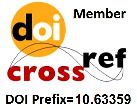Using Pollution Indices to Assess Heavy Metals Contaminated Soil in some Libyan Regions.
DOI:
https://doi.org/10.63359/xscykm31Keywords:
Soil, Pollution, Indices, Heavy metals, LibyaAbstract
Soil pollution by heavy metals is an important challenge facing many countries around the world, including Libya. This investigation was carried out across a heavy metals pollution in Libyan soil using pollution Indices such as Geo-accumulation index (i-GEO), contamination factor (CF), pollution load index (PLI), Contamination degree (CD), Modified contamination degree (mCD), Metal pollution index (MPI), overall metal contamination index (MCI). These pollution indices shed light on the quality of soil in Libya, and indicate that some of the heavy metals were unpolluted to severely extremely polluted with regard to i-GEO especially for Ni Cu & Pb, and the contamination factor were low to very high contamination status. the Most of the polluted soils fell within the industrial region. In particular, some of the sites in the industrial region showed high i-GEO. CF showed significant to very high contaminated for Ni, Cr, Zn, Cu and Pb for most of the sampling from the industrial area and also because they are closer to a major road intersection with a large traffic volume such as Benghazi, Al-marij Tripoli, Misurata & Khomes. The high CF index of heavy metals in soil made significant contribution recorded based on pollution load index (PLI). A very high pollution recorded in soils of Al-marij, Benghazi, Sirt, Zwara & Khomes with PLI ≥ 3. Also, very high contamination degree (CD > 24) was found in soils of Al-Marj, Benghazi, Misurata, Ejmail, Sirt, Zwara, Albayda & Khomes. Furthermore, the study confirmed that Al-Marj & Benghazi had the highest levels of overall metal contamination index (MCI). The results demonstrated that the values of MPI < 1 for all soils studied inducted that the overall of ecosystem is still non-polluted dilution and dispersion of heavy metals content due to large of the study area. However, the soil surrounding the biggest cities is heavily influenced by human activities, which causes massive accumulation of heavy metals in the soil in most regions. So, Monitoring and environmental audit should start into action to boost the environmental quality of Libyan soils.
References
Abbaslou H., Martin F., Abtahi A. and Moore F. (2014).Trace element concentrations and background values in the arid soils of Hormozgan Province of southern Iran. Archives of Agronomy and Soil Science. 60(8) 1125–1143.
Aishah RM, Shamshuddin J, Fauziah CI, Arifin A, Panhwar QA 2018, Adsorption-Desorption Characteristics Of Zinc And Copper In Oxisol And Ultisol Amended With Sewage Sludge. J.Chem.Soc.Pak.,. 40(. 05) 842- 855.
Artiola, J. F., Walworth, J. L., Musil, S. A., & Crimmins, M. A. (2019). Soil and Land Pollution. In Environmental and Pollution Science (pp. 219-235). Academic Press.
Barbieri, M. (2016). The importance of enrichment factor (EF) and geoaccumulation index (I-GEO) to evaluate the soil contamination. J Geol Geophys, 5(237), 2.
Bhutiani R., Kulkarni D.B., Khanna D.R., and Gautam A: 2017. Geochemical distribution and environmental risk assessment of heavy metals in groundwater of an industrial area and its surroundings, Haridwar, India, Energy, Ecology and Environment, 2(2): 155–167
Devanesan E., Suresh Gandhi M. , Selvapandiyan M. , Senthilkumar G. , Ravisankar R. (2017) Heavy metal and potential ecological risk assessment in sedimentscollected from Poombuhar to Karaikal Coast of Tamilnadu using Energy dispersive X-ray fluorescence (EDXRF) technique. Beni-Suef University Journal of Basic and Applied Sciences 6 : 285–292
Islam, M. S., Ahmed, M. K., Habibullah-AL-MAMUN, M., & ISLAM, S. M. A. (2017). Sources and ecological risk of heavy metals in soils of different land uses in Bangladesh. Pedosphere.
Jia, Z., Li, S., & Wang, L. (2018). Assessment of soil heavy metals for eco-environment and human health in a rapidly urbanization area of the upper Yangtze Basin. Scientific reports, 8(1), 3256.
Khan, M. A., Khan, S., Khan, A., & Alam, M. (2017). Soil contamination with cadmium, consequences and remediation using organic amendments. Science of the Total Environment, 601, 1591-1605.
Liu, C., Cui, J., Jiang, G., Chen, X., Wang, L., & Fang, C. (2013). Soil heavy metal pollution assessment near the largest landfill of China. Soil and Sediment Contamination: An International Journal, 22(4), 390-403.
Luo X, Yu S, Li X (2012) The mobility, bioavailability, and human bioaccessibility of trace metals in urban soils of Hong Kong. Appl Geochem 27:995–1004
Mayouf, J. A.. Najim, Q. A & Al-Bayati H. S.(2014): Determination of Cadmium and Lead in Sewage Sludge from the Middle Region (Misrata, Msallataand Tarhünah Cities) of Libya. International Journal of Chemical and Molecular Engineering.Vol:8, No:9, 2014
Mazurek R., Kowalska J., Gasiorek M., Zadrozny P., Jozefowska A., Zaleski T., Kepka W., Tymczuk M., and Orłowska K., 2017, Assessment of heavy metals contamination in surface layers of Roztocze National Park forest soils (SE Poland) by indices of pollution, Chemosphere, 168: 839 – 850
Mishra, S., Bharagava, R. N., More, N., Yadav, A., Zainith, S., Mani, S., & Chowdhary, P. (2019). Heavy Metal Contamination: An Alarming Threat to Environment and Human Health. In Environmental Biotechnology: For Sustainable Future (pp. 103-125). Springer, Singapore.
Ololade, I.A. (2014) An Assessment of Heavy-Metal Contamination in Soils within Auto-Mechanic Workshops Using Enrichment and Contamination Factors with Geoaccumulation Indexes. Journal of Environmental Protection, 5, 970-982.
Roudposhti, G. M., Karbassi, A., & Baghvand, A. (2016). A pollution index for agricultural soils. Archives of Agronomy and Soil Science, 62(10), 1411-1424.
Salah E. & Noori S. A., (2013) Heavy Metals Concentration in Urban Soils of Fallujah City, Iraq. Journal of Environment and Earth Science. Vol. 3, No.11, 100-112
Sodango, T. H., Li, X., Sha, J., & Bao, Z. (2018). Review of the Spatial Distribution, Source and Extent of Heavy Metal Pollution of Soil in China: Impacts and Mitigation Approaches. Journal of Health and Pollution, 8(17), 53-70.
Sun, Y. (2017). Ecological Risk Evaluation of Heavy Metal Pollution in Soil Based on Simulation. Polish Journal of Environmental Studies, 26(4).
Thambavani, S. D., & Uma Mageswari, U. T. S. R. (2013). Metal pollution assessment in ground water. Bulletin of Environmental Pharmacology Life Science, 2(12), 122-129.
Weissmannová, H. D., & Pavlovský, J. (2017). Indices of soil contamination by heavy metals–methodology of calculation for pollution assessment (minireview). Environmental monitoring and assessment, 189(12), 616.
Zhang, M., He, P., Qiao, G., Huang, J., Yuan, X., & Li, Q. (2019). Heavy metal contamination assessment of surface sediments of the Subei Shoal, China: Spatial distribution, source apportionment and ecological risk. Chemosphere.
Downloads
Published
Issue
Section
License

This work is licensed under a Creative Commons Attribution-NonCommercial 4.0 International License.














